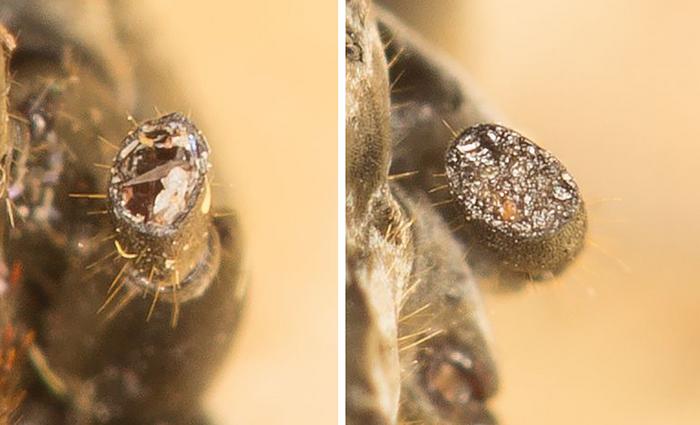Life is dangerous when your prey is good at fighting back. That’s the fate of Matabele ants, which live on termites. After the struggle to overcome termite soldiers and get at the vulnerable nest, many ants carry injuries. Fortunately for them, their nestmates don’t believe in leaving a soldier on the battlefield, instead performing advanced wound care.
The major injuries Matabele ants (Megaponera analis) suffer are from the termite soldiers’ mandibles. Besides the immediate damage to limbs, the wounds can get infected, but the ants have not only developed an array of antibiotic treatments, they also recognize when to deploy them, saving most injured warriors.
Dr Erik Frank of Julius-Maximilians-Universität (JMU) Würzburg led a team investigating how M. analis survives injuries. As they note, animals in general often die from infections, and the risk is particularly high among group-living species, where pathogens can be easily transmitted. Many mammals have molecules in their saliva with antiseptic properties and are known to lick their wounds, presumably to try to restrict bacterial growth.
However, according to Frank and colleagues, it doesn’t seem like so-called higher animals can tell if a wound is infected – the licking is performed automatically. Despite their tiny brains, ants turn out to be more discriminating.
Observations of ant vs termite battles have recorded up to 22 percent of the attackers losing one or more legs. Their comrades in legs, however, carry them back to the nest where the wound is licked and groomed within three hours of being sustained.
The authors have previously reported that 90 percent of untreated ants die within 24 hours. Tusk and co-authors set out to see what kills the ants, and what happens when they are treated.
They found the main cause of death is the bacterium Pseudomonas aeruginosa. While it would be foolish to suggest the ants know this, they respond differently to wounds that are infected with P. aeruginosa, treating them more frequently.
The ants produce 112 organic compounds, 23 of them unknown to science, from their metapleural gland, putting many pharmacies to shame. Frank and colleagues tested these and found around half of them have either antimicrobial properties or heal wounds in other ways. The purpose of the others is not clear.
“With the exception of humans, I know of no other living creature that can carry out such sophisticated medical wound treatments,” Frank said in a statement.

A wounded leg (left) appears to have healed an hour after treatment by fellow ants.
Image Credit: Erik Frank / University of Wuerzburg
Presumably, these molecules take a lot of effort to produce, so the ants don’t want to waste them on clean wounds, and have developed the capacity to detect P. aeruginosa, and perhaps some other threatening bacteria. Other species of ants, living less hazardous lifestyles, produce far fewer chemicals with potential antibiotic profiles. Their secretions are thought to be mostly useful when infections have barely taken hold.
The treatments are necessary because lethal bacteria are common in the ants’ environment. When the authors applied soil from areas inhabited by M. analis to wounds bacterial loads skyrocketed within two hours, not only at the site, but in the ants’ thoraxes.
When infected ants were placed in isolation, 90 percent of them died within 36 hours, but this fell to 22 percent among those returned to the colony, demonstrating the effectiveness of the treatment. On the other hand, ants that were injured, but not infected, had similar survival rates alone or in the nest. The death rate was higher (93 percent) for untreated ants infected specifically with P. aeruginosa, rather than a mix of soil bacteria, but survival in the nest was even higher.
Not surprisingly, the authors suggest that gene coding for the most abundant anti-microbial proteins could be a worthy subject for investigation in a world facing rising antibiotic resistance. They note P. aeruginosa is a leading cause of combat wounds in humans as well.
The study is published open access in Nature Communications. The work also features in the fifth episode of Netflix’s Life On Our Planet, executive produced by Steven Spielberg, with the film crew working closely with the researchers both in the wild and the laboratory.
Source Link: After Battle, These Ants Tend Each Others’ Wounds With Antibiotics